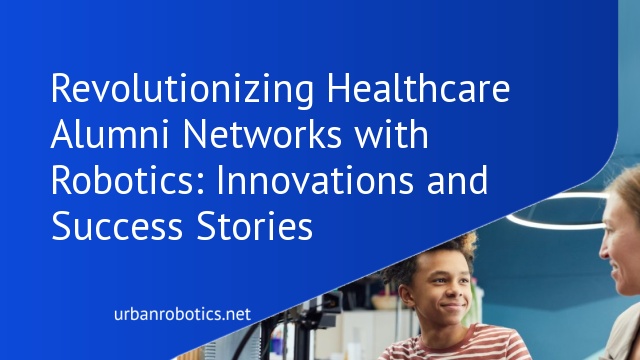Overview Of Healthcare Alumni Networks
Healthcare alumni networks facilitate ongoing collaboration among medical professionals. These networks offer platforms for sharing best practices, research findings, and innovations. Alumni can discuss their experiences, enhance skills, and remain updated on advancements.
Institutions often support alumni networks with resources like online portals, annual conferences, and professional development programs. For example, Harvard Medical School’s alumni association provides access to exclusive workshops and databases. Such resources help members stay connected and well-informed.
Robust alumni networks also contribute to career growth. Members can explore job opportunities, receive mentorship, and engage in networking events. These interactions often result in improved patient care and the collective advancement of the healthcare industry. With robotics becoming central to modern medicine, integrating this field within our alumni networks is crucial for overall progress.
The Role Of Robotics In Healthcare
Robotics has revolutionized healthcare, offering precision, efficiency, and innovation. These advancements pave the way for improved patient outcomes and streamlined medical procedures.
Evolution Of Robotics In Medicine
Robotics in medicine began with robotic-assisted surgery in the 1980s. The introduction of the da Vinci Surgical System in 2000 marked a significant leap. This system allowed for minimally invasive surgeries with greater accuracy. Since then, robotics has expanded to include areas like diagnostic imaging, rehabilitation, and telemedicine, drastically improving medical care and patient recovery rates.
Key Areas Where Robotics Are Used
Robots are utilized in several medical fields. In surgery, robotic systems enable precision and reduce recovery times. In diagnostics, robots assist in accurate imaging and analysis. Rehabilitation robots aid patients in physical therapy. Telemedicine employs robots for remote patient monitoring and consultations, providing access to healthcare in underserved regions. These areas highlight the transformative impact of robotics in modern medicine.
Integration Of Robotics Into Alumni Networks
Combining robotics with healthcare alumni networks enhances professional growth by fostering innovation. This integration optimizes collaboration among former colleagues and enriches collective expertise.
Benefits Of Combining Robotics And Alumni Networks
Robotics and alumni networks jointly enhance skill development and knowledge exchange. Professionals share real-world applications and outcomes of robotic technologies, broadening their understanding. Alumni events may feature robotic demonstrations, furthering hands-on learning. This synergy leads to improved patient care by incorporating cutting-edge technologies into everyday practice.
Challenges And Considerations
Integrating robotics into alumni networks poses logistical and financial challenges. Ensuring access to emerging robotic technologies requires significant investment, which can strain resources. Additionally, standardized training must be implemented to avoid disparities in proficiency among alumni. We need to establish clear protocols to address these challenges and ensure equitable, high-quality professional development opportunities.
Case Studies
These case studies illustrate the impact and outcomes of integrating robotics into healthcare alumni networks.
Successful Healthcare Alumni Networks With Robotics
Penn Medicine and the University of Pennsylvania established a successful alumni network integrating robotics. Alumni reported increased knowledge-sharing, particularly in robotic-assisted surgeries. These networks hosted regular webinars covering new robotic technologies, enhancing collaboration. The Mayo Clinic alumni network also saw success by creating focus groups for discussing robotic innovations, which led to the development of new surgical techniques. Multiple institutions, including Stanford Medicine, utilized similar networks to facilitate ongoing professional development among alumni.
Lessons Learned From Case Studies
Case studies revealed key lessons. Consistent communication channels, such as online forums and regular virtual meetings, are crucial. Institutions discovered the importance of offering continuous education and training to stay abreast of evolving robotic technologies. Another lesson emphasized collaboration between alumni and current faculty to ensure the latest practices are shared. Financial support from institutions and external grants proved essential for rollouts and scaling.
Future Prospects
Healthcare alumni networks with robotics are poised to transform medical education and practice dramatically. Emerging innovations and their potential impacts highlight the future’s exciting possibilities.
Innovations On The Horizon
Cutting-edge robotics innovations promise substantial advancements. AI-driven robots, versatile surgical instruments, and remote-controlled robotic systems are some examples. These technologies improve precision and expand accessibility in healthcare settings. Moreover, nanorobotics might soon revolutionize diagnostics and treatment at a cellular level. By integrating these innovations, alumni networks can pioneer groundbreaking medical techniques.
Potential Impact On Medical Education And Practice
Robotics will redefine medical education by introducing advanced simulation tools, enhancing learning experiences. Remote learning assets, such as VR and AR, will allow alumni to train in realistic, controlled environments. In practice, robotics support greater precision in surgeries, reduced recovery times, and improved patient outcomes. By adopting these technologies, our alumni networks can significantly enhance healthcare delivery and education standards.
Conclusion
Healthcare alumni networks equipped with robotics are poised to revolutionize medical education and practice. By leveraging advanced technologies like AI-driven robots and nanorobotics, we can enhance surgical precision and improve patient outcomes. These networks foster continuous education and collaboration, ensuring that medical professionals stay at the forefront of innovation. As we look to the future, the integration of VR and AR in training will further elevate our standards, making healthcare more accessible and effective. Embracing these advancements within our alumni networks will undoubtedly lead to a new era of medical excellence.





